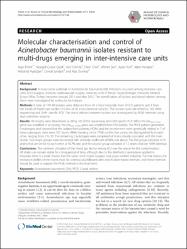| dc.contributor.author | Ertürk, Ayşe | |
| dc.contributor.author | Çiçek, Ayşegül Çopur | |
| dc.contributor.author | Gümüş, Aziz | |
| dc.contributor.author | Cüre, Erkan | |
| dc.contributor.author | Şen, Ahmet | |
| dc.contributor.author | Kurt, Aysel | |
| dc.contributor.author | Karagöz, Alper | |
| dc.contributor.author | Aydoğan, Nebahat | |
| dc.contributor.author | Sandallı, Cemal | |
| dc.contributor.author | Durmaz, Rıza | |
| dc.date.accessioned | 2020-12-19T20:03:06Z | |
| dc.date.available | 2020-12-19T20:03:06Z | |
| dc.date.issued | 2014 | |
| dc.identifier.citation | Erturk, A., Cicek, A.C., Gumus, A., Cure, E., Sen, A., Kurt, A., Karagoz, A., Aydogan, N. ve diğerleri (2014).Molecular characterisation and control of Acinetobacter baumannii isolates resistant to multi-drugs emerging in inter-intensive care units.Annals of Clinical Microbiology and Antimicrobials, 13, 36.https://doi.org/10.1186/s12941-014-0036-2 | |
| dc.identifier.issn | 1476-0711 | |
| dc.identifier.uri | https://doi.org/10.1186/s12941-014-0036-2 | |
| dc.identifier.uri | https://hdl.handle.net/11436/3092 | |
| dc.description | cure, erkan/0000-0001-7807-135X; SANDALLI, Cemal/0000-0002-1298-3687; ERTURK, AYSE/0000-0001-6413-9165 | en_US |
| dc.description | WOS: 000339850600001 | en_US |
| dc.description | PubMed: 25048577 | en_US |
| dc.description.abstract | Background: A nosocomial outbreak of Acinetobacter baumannii (AB) infections occurred among intensive care units (ICU) (surgery, medical, cardiovascular surgery, coronary unit) of Recep Tayyip Erdogan University Medical School (Rize, Turkey) between January 2011 and May 2012. the identification of isolates and clonal relation among them were investigated by molecular techniques. Methods: A total of 109 AB isolates were obtained from 64 clinical materials from 54 ICU patients and 3 from the hands of healthcare workers (HCWs) of 42 environmental samples. the isolates were identified by 16S rDNA sequencing and OXA-specific PCR. the clonal relation between isolates was investigated by PFGE methods using ApaI restriction enzyme. Results: All isolates were determined as AB by 16S rDNA sequencing and OXA-spesific PCR. While the bla(OXA-51-like) gene was amplified in all isolates, the bla(OXA-23-like) gene was amplified from 103 isolates. the PFGE pattern generated 9 pulsotypes and showed that the isolates from patients, HCWs, and the environment were genetically related. in 7 of these pulsotypes, there were 107 strains (98%) showing similar PFGE profiles that cannot be distinguished from each other, ranging from 2 to 53. the remaining 2 pulsotypes were comprised of strains closely associated with the main cluster. Two major groups were discovered with similarity coefficient of 85% and above. the first group consisted of 97 strains that are similar to each other at 92.7% rate, and the second group consisted of 12 strains that are 100% identical. Conclusions: the common utilization of the blood gas device among ICU was the reason for the contamination. AB strains can remain stable for a long period of time, although due to the disinfection procedures applied in hospitals, there is a small chance that the same clone might reappear and cause another epidemic. For that reason, the resistance profiles of the strains must be continuously followed with amplification-based methods, and these methods should be used to support the PFGE method in the short term. | en_US |
| dc.description.sponsorship | Recep Tayyip Erdogan UniversityRecep Tayyip Erdogan University [BAP-2013.102.03.13, BAP-2013.102.03.12, BAP-2013.102.03.4] | en_US |
| dc.description.sponsorship | This work was supported by Recep Tayyip Erdogan University Research Fund Grants BAP-2013.102.03.13, BAP-2013.102.03.12 and BAP-2013.102.03.4. | en_US |
| dc.language.iso | eng | en_US |
| dc.publisher | Bmc | en_US |
| dc.publisher | BMC | |
| dc.rights | info:eu-repo/semantics/openAccess | en_US |
| dc.subject | Acinetobacter baumannii | en_US |
| dc.subject | OXA | en_US |
| dc.subject | PFGE | en_US |
| dc.subject | Clonal relation | en_US |
| dc.subject | Acinetobacter baumannii | en_US |
| dc.subject | Clonal relation | en_US |
| dc.title | Molecular characterisation and control of Acinetobacter baumannii isolates resistant to multi-drugs emerging in inter-intensive care units | en_US |
| dc.type | article | en_US |
| dc.contributor.department | RTEÜ, Tıp Fakültesi, Dahili Tıp Bilimleri Bölümü | en_US |
| dc.contributor.institutionauthor | Ertürk, Ayşe | |
| dc.contributor.institutionauthor | Gümüş, Aziz | |
| dc.contributor.institutionauthor | Cüre, Erkan | |
| dc.contributor.institutionauthor | Şen, Ahmet | |
| dc.contributor.institutionauthor | Kurt, Aysel | |
| dc.contributor.institutionauthor | Aydoğan, Nebahat | |
| dc.contributor.institutionauthor | Sandallı, Cemal | |
| dc.identifier.doi | 10.1186/s12941-014-0036-2 | |
| dc.identifier.volume | 13 | en_US |
| dc.ri.edit | oa | en_US |
| dc.relation.journal | Annals of Clinical Microbiology and Antimicrobials | en_US |
| dc.relation.publicationcategory | Makale - Uluslararası Hakemli Dergi - Kurum Öğretim Elemanı | en_US |


















